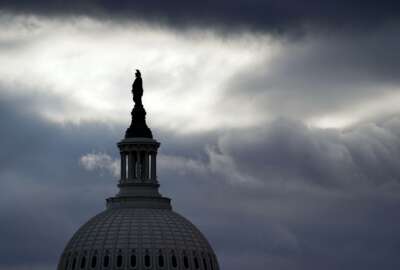
Another court rules in favor of Navy sailors who refuse COVID-19 vaccine
In today's Federal Newscast, a federal judge in Texas has blocked the Navy from enforcing its COVID vaccine mandate against nearly 4,000 sailors who’d filed...
To listen to the Federal Newscast on your phone or mobile device, subscribe in PodcastOne or Apple Podcasts. The best listening experience on desktop can be found using Chrome, Firefox or Safari.
- A federal judge in Texas has blocked the Navy from enforcing its COVID vaccine mandate against nearly 4,000 sailors who filed religious exemptions. The new decision vastly expands an earlier court order that only covered a few dozen sailors, and certifies the case as a class action lawsuit. In keeping with a recent Supreme Court decision, the Navy can use those sailors’ vaccination status to make deployment and assignment decisions, but can’t take other disciplinary action against them for refusing the vaccine.
- Republican House lawmakers are posing more questions about return-to-office plans for federal employees. Two ranking members of the Committee on Oversight and Reform want a clearer picture of whether those workers will have in-person or hybrid schedules. Reps. Jody Hice (R-Ga.) and James Comer (R-Ky.) wrote to leaders at the Office of Personnel Management and the General Services Administration. They are asking for a date that most federal workers will come back in person. GSA and OPM have until April 13 to respond.
- The Commerce Department is telling all its employees to come back to the office by the end of April. The department expects all its employees to return to the office starting April 25, and expects employees to generally be able to telework up to two days per week. But some employees may be able to telework more than that. The agency said it’s working with its bureaus to expand telework options beyond its baseline of two days a week. Commerce cited President Joe Biden’s State of the Union address as the impetus for its office reentry plans. Commerce told staff it will provide more information about returning to the office over the next few weeks. (Federal News Network)
- The Department of Housing and Urban Development is outlining a phased reentry for its employees starting April 25. That’s when HUD lifts its maximum telework policy that’s been in place since the start of the COVID-19 pandemic. HUD told employees to report to their official duty stations at least twice a pay period for two pay periods. HUD expects to complete the first phase of its office reentry plans the week of May 23. The agency tells employees they’ll receive further guidance in the coming weeks about the second phase. (Federal News Network)
- The Coast Guard is often forgotten in the shadow of the Defense Department’s much larger budget. But this year, the service is asking for a bit of a boost. The Coast Guard is asking for $13.8 billion and wants to use $125 million to procure a commercial icebreaker. It hopes to use that ship in polar regions until the first of six new icebreakers are completed in the 2025 timeframe. The service is seeing more activity in those areas as the ice caps continue to melt. Other budget items include $650 million for offshore patrol cutters and $100 million to keep ships in good repair. (Federal News Network)
- Lawmakers are giving the Defense Department ideas on how to use its new basic needs income authority. The 2022 defense authorization act allows the Pentagon to give low-income service members a stipend for food and other needs. Legislators on multiple committees suggest giving service members an opt-out option if they do not want to be part of the program. Another suggestion is to exclude basic allowance for housing as an income consideration when deciding if a military family needs a basic income stipend.
- GSA’s Technology Transformation Service and the Air Force’s Kessel Run office are offering a glimpse of what the future of federal websites and customer experience could look like. TTS and Kessel Run collaborated to develop a proof of concept to let the cloud dot gov platform host 100 million users at the same time. Kessel Run’s Bowcaster team provided “chaos engineering” services to help TTS’s platform scale its capacity. Bowcaster provided load testing, penetration testing and other services to ensure the cloud dot gov platform could meet availability and resiliency requirements that highly trafficked applications need.
- Another federal agency CIO is on the move. Lytwaive Hutchinson the CIO for FEMA since 2019 is leaving to join the private sector. Hutchinson confirmed to Federal News Network that she plans to end her 41-year career in federal service. During her time at FEMA, Hutchinson focused on IT modernization goals, including moving more applications and systems to the cloud, addressing customer experience challenges and, of course, cybersecurity. Hutchinson came to FEMA after spending her entire federal career working for the Defense Department. She served in the Army for 21 years and then worked in various civilian positions in the DoD CIO’s office. (Federal News Network)
- IRS is naming new executives to serve in some key roles. The IRS hired Todd Anthony to serve as its chief procurement officer. Anthony previously served as the associate director for enterprise procurement initiatives at the Education Department and as a senior procurement executive at the Office of Personnel Management. The IRS has also named Mark Pursley as its new chief risk officer. Pursley previously served as the director for Servicewide Operations for IRS.
- Congressional auditors said U.S. Cyber Command needs a better way of measuring progress for a key acquisition initiative. CYBERCOM is overseeing the development and fielding of the Joint Cyber Warfighting Architecture. But the Government Accountability Office said the command lacks good metrics to evaluate the performance of the new cyber warfighting systems. CYBERCOM told GAO that it plans on fine tuning the metrics through a series of assessments this year.
- A new White House cyber office is starting to take shape. National Cyber Director Chris Inglis said his new office now employs about 30 people, with a goal to one day reach 90. The office was just established last summer to drive stronger cyber resilience across public and private sectors. It received $21 million from Congress in last year’s infrastructure bill, and the Biden administration is requesting another $22 million for next year. Inglis said the office’s efforts are just getting started. “I’m pleased to say that now about eight months into my tenure, and probably two and a half months into the funding, we’re in a place where we have very significant lines of effort underway,” he said. (Federal News Network)
- The House’s SECURE Act is one step closer to becoming law. The House passed the bill on Tuesday evening, making it easier for federal employees to save more as they get closer to retirement. Under the bill, participants in the Thrift Savings Plan will see an increase in the required start date for TSP distributions. The House is urging the Senate to act quickly so the Securing a Strong Retirement Act can move to the President for signing.
Copyright © 2025 Federal News Network. All rights reserved. This website is not intended for users located within the European Economic Area.
Eric White
Eric White is news anchor and Federal Drive producer at Federal News Network.
Follow @FEDERALNEWSCAST
Related Stories
Related Topics
All News
Chris Inglis
Coast Guard
Commerce Department
Covid-19
COVID-19 vaccine mandate
customer experience
Cyber Command
Defense
Defense News
Department of Housing and Urban Development
Federal Drive
Federal Newscast
federal websites
FEMA
General Services Administration
Government Accountability Office
IRS
James Comer
Jody Hice
Joint Cyber Warfighting Architecture
Kessel Run
Lytwaive Hutchinson
Management
Mark Pursley
National & World Headlines
Navy
Office of Personnel Management
office reentry
reentry
Supreme Court
telework
Texas
Todd Anthony
Tom Temin
Workforce
Workforce Rights/Governance





